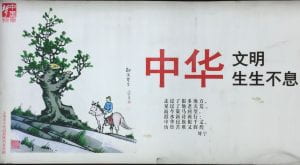Friday, October 25, 4:30-6:30 pm, the Cochrane-Woods Art Center (CWAC) Room 156.
Peter Chen, MA student, Divinity School
“What does Chinese look like? Secularization as/and Nationalism in the case of Feng Zikai”
Respondent: Minori Egashira, PhD student, Department of Art History
A pre-circulated paper can be found at the link, pin: zikai.
Co-sponsored with Arts and Politics of East Asia (APEA) Workshop
This paper attempts to link broader theoretical discussions regarding secularization with the formation of nationalism and “Chinese-ness” in contemporary China. In particular, I focus here on the contemporary afterlife of Feng Zikai 豐子愷 (1898 – 1975) in the PRC through the China Dream campaign 中國夢posters and in Taiwan through religious murals at Foguangshan 佛光山. While the China Dream posters represent Feng Zikai as a secular figure, the murals at Foguangshan paint him as a Chinese Buddhist exemplar. Furthermore, while the China Dream campaign has preserved the ink and watercolor style of Feng Zikai’s original manhua (漫畫), Foguangshan has transformed his work into the ceramic religious murals, similar to those commonly found in popular religious temples in China and Taiwan. The paper attempts to interrogate under what structures and conditions these types of images make sense and accordingly, how they fit into current discourses surrounding what constitutes Chinese-ness. Thus, I first outline how figures such as Hu Shi 胡適 (1891-1962) first laid down theoretical and conceptual paradigms concerning secularism and Chinese-ness in order to understand how these frameworks still function today. In short, starting from Hu Shi’s writings on the history of Chinese philosophy and religion, a discourse connecting secularism and ‘Chinese-ness’ emerges, and that this intertwining of secularism and the narrative concerning the state of Chinese culture critically informs these two re-interpretations of Feng Zikai’s work in order to produce two contrasting visual depictions of ‘Chinese-ness.’

A popular China Dream poster with an image of Feng Zikai’s manhua.
Persons with concerns regarding accessibility please contact Zhenru Zhou (zhenru@zhenruzhou.com) and Yin Wu (yinwu@uchicago.edu).
++++++++++++++++++++++++++++
Peter Chen is a MA student at the Divinity School. His current research interests revolve around secularism, nationalism, visual culture, and the formation and differentiation of knowledge production in modern East Asia. Prior to coming to University of Chicago, he spent a year between Hangzhou and Beijing on a Fulbright grant, conducting research on Feng Zikai. Moving forward, he is interested in how the secular and the religious intersect with the formations of the social sciences and political theory in China, as seen through Buddhist historiography, late Qing political thought, Maoism, and Cold War propaganda posters.
Minori Egashira is a PhD student at the Department of Art History. She studies Japanese art history, with a focus on Meiji-period (1868–1912) sculpture. She is interested in how Japanese artworks were transferred to the West and their reception by both the West and Japan. She received her BA in art history from Wake Forest University in 2014, and her MA from Kyushu University in 2017. She completed her MA thesis on changing perceptions of Meiji-period artists during their lifetimes and the reception of their artworks. Specifically, she examined Buddhist wood sculptor and professor Takenouchi Hisakazu (1857–1916, alt. Takeuchi Kyūichi) and the lacunae of scholarship on him.


